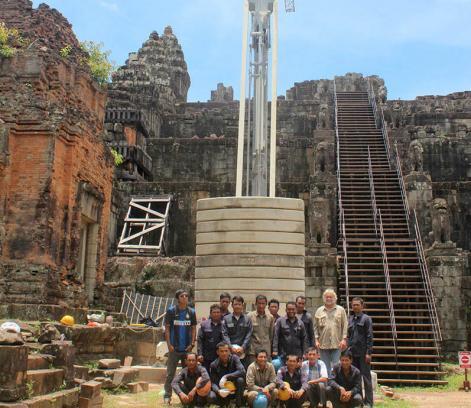Moving a Crane at Phnom Bakheng

After restoration work at the northeast corner of Angkor’s Phnom Bakheng temple was completed at the end of June, the WMF team started focusing its efforts on the north elevation. To this end, it was necessary to move the smaller crane originally located at the northeast corner to the new location. WMF asked technical consultant Warren Wilford to help the Cambodian team with the tasks of dismantling, moving, and re-erecting the crane. Warren has been consulting for WMF for almost 10 years. He has held training sessions on how to use the cranes at Phnom Bakheng and at the Churning of the Sea of Milk gallery of Angkor Wat, and also on how to lift and transport blocks safely.
Tasks like lowering the crane jib and the tower or re-erecting them in different locations are fully automatic and activated with a controller. But other tasks required the team to manually intervene: unloading the counterweight, bringing the crane down the ramp and moving it to the new location, and installing and removing the wheels. About 30 WMF workers participated in this mission. Warren said that dismantling, moving, and re-erecting a crane requires following a series of tasks in the right sequence; however, problems arise when something doesn’t go the way it is expected to. In these moments, understanding the mechanical, electrical, and hydraulic function of a crane is fundamental to get through any difficulties. The whole process of moving the crane was also an occasion to hear Warren’s perception on how the WMF team has changed through time. All the workers, he observed, proved extremely responsive and self-confident at every step of the work. Everyone seemed to know what was coming next and they were always prepared for it. Warren commented, “The team seems to have fully embraced the crane.” When the cranes were installed for the first time a few years ago, Warren explained how people were very hesitant and uncomfortable operating or touching them, and it was necessary to guide them through the whole process step by step. But now, the team instead showed a total absence of fear in taking initiative and proposing ways to solve issues that arose along the way. This is the result of the participatory approach promoted by WMF Cambodian staff, encouraging people to express their point of view and keeping them involved in all work tasks.
The maturity of the team is also the result of WMF’s efforts towards keeping the same people over time by offering fair and attractive working conditions. The stability of a team, which benefits from continuous training over the years, is a success of WMF’s work in Cambodia. Warren told me how, at the worksite in Angkor Wat’s Churning of the Sea of Milk gallery between 2007 and 2011, he was impressed by Mr. Mou Var, a worker who was employed by WMF in one of its first missions to Cambodia in 1992, and his critical thinking skills and his strong will to learn and take initiative. Today Mou Var is Site Manager at Phnom Bakheng, responsible for WMF’s largest project in Cambodia and in the world. The crane was successfully re-erected at the new location on August 29, 2015, with joy and enthusiasm from the whole team!
The project is funded by the Ambassadors Fund for Cultural Preservation and the U.S. Embassy in Phnom Penh.
